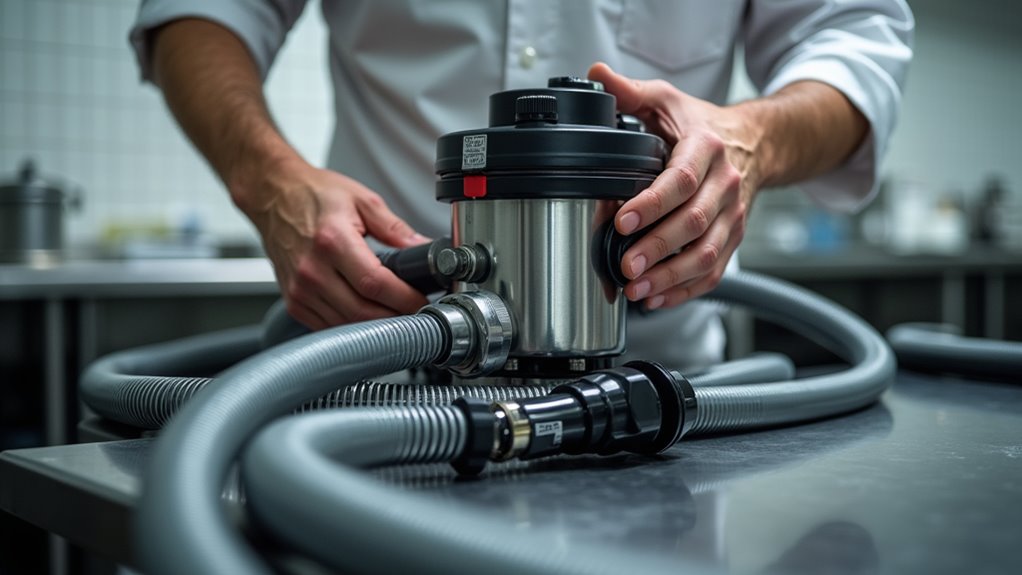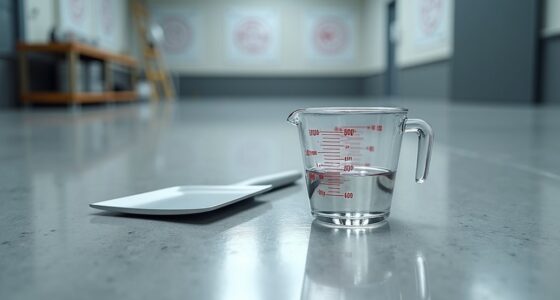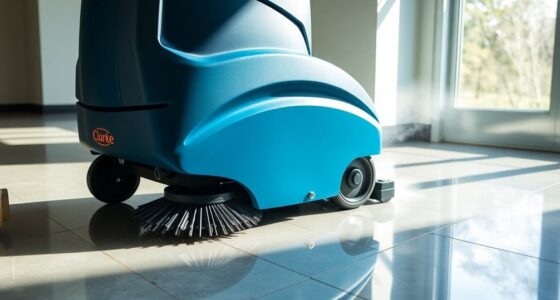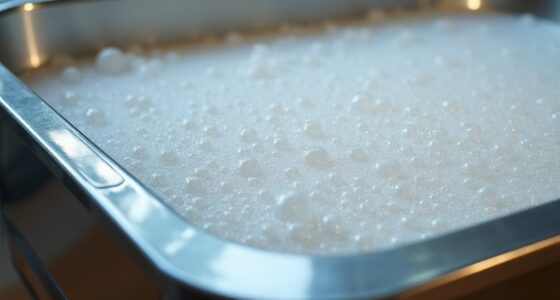If your restaurant vacuum isn’t picking up well, start by inspecting the hose for blockages, cracks, or leaks, and clear any debris gently with a tool like a broomstick. Check the motor for unusual noises, overheating, or dirt buildup that could strain it. Make certain filters are clean and connections tight to maintain suction. Addressing these issues can restore performance, and if you want detailed steps, there’s more to discover below.
Key Takeaways
- Inspect the vacuum motor for unusual noises, overheating, or signs of dirt buildup that may cause shutdowns or reduced suction.
- Check electrical connections and clean or replace filters to prevent airflow obstructions affecting pickup performance.
- Remove and examine the hose for blockages, cracks, or leaks that could compromise suction power.
- Ensure vacuum attachments and brushes are free of debris and not clogged, supporting efficient cleaning.
- Perform routine maintenance and professional inspections to identify early issues and maintain optimal vacuum operation.
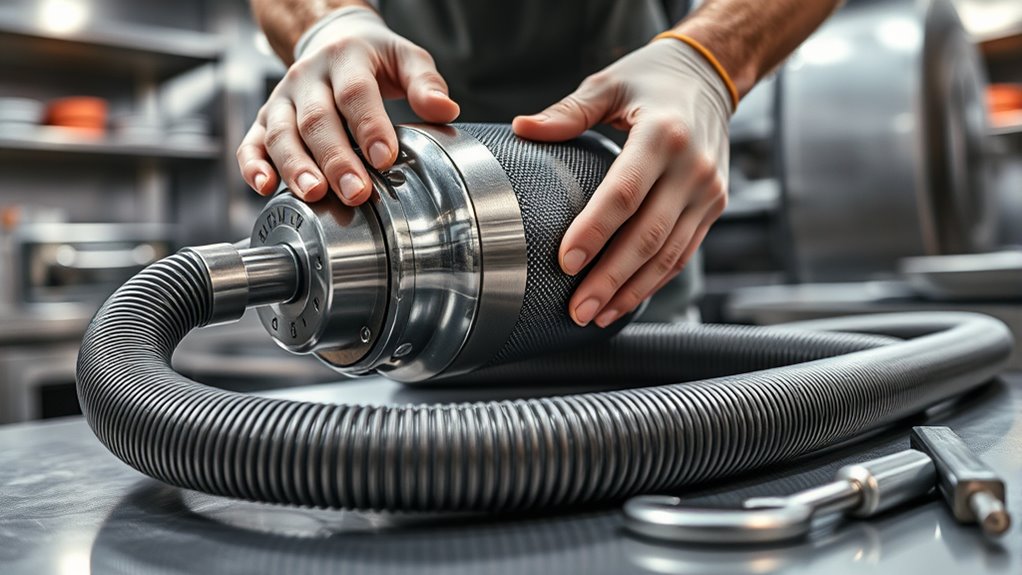
Regularly checking your vacuum motor and hose in a restaurant kitchen is crucial to maintaining a clean and efficient environment. Proper equipment maintenance ensures that your vacuum system functions reliably, preventing downtime and costly repairs. When you notice a lack of pickup or diminished suction, it’s time to inspect the motor and hose thoroughly. Troubleshooting tips focus on identifying common issues early, helping you keep the cleaning process smooth and effective.
Start by examining the vacuum motor. Listen carefully for unusual noises like grinding or squealing, which can indicate motor strain or impending failure. If the motor is overheating or shutting down prematurely, it might be due to dirt buildup, worn brushes, or electrical issues. Regular maintenance involves cleaning or replacing filters and checking for dust or debris that could obstruct airflow. Keeping the motor clean prolongs its lifespan and ensures consistent performance. If you’re comfortable with electrical components, you can safely inspect connections for looseness or corrosion. Otherwise, it’s best to call in a professional for detailed repairs. Additionally, ensuring proper ventilation helps prevent motor overheating and maintains safe operation.
Next, inspect the hose. A common cause of pickup problems is a clogged or damaged hose. Remove the hose and look for blockages such as debris, tangled cords, or buildup that restrict airflow. Use a broomstick or similar tool to clear out any obstructions gently. Check the hose for cracks, tears, or holes that could cause leaks and reduce suction power. If you find damage, replacing the hose promptly is essential to restore effective cleaning. When inspecting, also ensure the hose connections are tight and secure, as loose fittings can lead to loss of suction.
Troubleshooting tips also include verifying the vacuum head and attachments. Sometimes, a clogged brush or nozzle can mimic motor or hose issues. Remove and clean these parts regularly to prevent airflow restrictions. Additionally, ensure the filters are clean and replaced as needed because dirty filters can reduce suction and strain the motor, leading to potential failures.
Frequently Asked Questions
How Often Should Vacuum Motors Be Inspected for Optimal Performance?
You should inspect your vacuum motor at least every three to six months to guarantee peak performance. Regular inspections help extend the vacuum motor lifespan and prevent unexpected breakdowns. During each check, look for signs of wear, debris buildup, or unusual noises. Maintaining a consistent inspection frequency keeps your restaurant’s kitchen equipment running smoothly, reducing downtime and costly repairs. Stay proactive to ensure your vacuum system operates efficiently when you need it most.
What Signs Indicate a Vacuum Hose Needs Replacement?
Imagine a worn garden hose leaking water—vacuum hoses show damage in similar ways. You’ll notice cracks, tears, or stiffness that hinder suction, along with persistent clogs or reduced airflow. These signs of vacuum hose damage mean it’s time for hose replacement. Don’t ignore these cues; replacing damaged hoses guarantees your restaurant’s vacuum system works efficiently, preventing downtime and maintaining a clean, safe environment.
Can Vacuum Motor Issues Affect Kitchen Air Quality?
Vacuum motor issues can substantially affect your kitchen’s air quality by increasing vacuum emissions, which may release dust, grease, or other particles into the air. When the motor struggles or malfunctions, it may not filter properly, leading to poor air conditions. Regularly checking and maintaining your vacuum system ensures it operates efficiently, reducing emissions and keeping the air in your kitchen cleaner and healthier for staff and customers alike.
Are There DIY Steps to Troubleshoot Vacuum Motor Failures?
Like a knight’s armor needs constant upkeep, your vacuum motor requires regular checks. To troubleshoot vacuum issues, start by inspecting the hose for clogs, then listen for unusual noises. Confirm the motor is receiving power; if not, check the fuse or switch. If these steps don’t work, consider troubleshooting vacuum issues further or replacing the vacuum motor. For persistent problems, vacuum motor replacement might be necessary to restore proper suction.
What Are the Best Practices for Maintaining Vacuum Hoses in Busy Kitchens?
To keep your vacuum hoses in busy kitchens working smoothly, regularly check and tighten hose clamps to prevent leaks. Establish a consistent cleaning schedule to remove debris and buildup that can clog hoses. Also, inspect hoses for cracks or damage, replacing them as needed. Properly maintained hoses ensure maximum suction, reduce downtime, and extend equipment lifespan, making your kitchen safer and more efficient.
Conclusion
Regularly checking your vacuum motor and hose can prevent costly downtime in your restaurant. Did you know that 70% of kitchen equipment failures are caused by simple maintenance issues? By performing quick inspections, you avoid unexpected breakdowns and keep your kitchen running smoothly. Stay proactive, and you’ll save money and ensure a cleaner, safer environment for your staff and customers. Don’t wait for a problem—check those motors and hoses consistently to keep your restaurant at its best.
